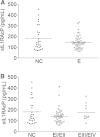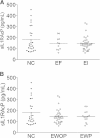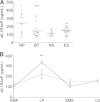Blood soluble interleukin 1 receptor accessory protein levels are consistently low throughout the menstrual cycle of women with endometriosis
- PMID: 24935223
- PMCID: PMC4072478
- DOI: 10.1186/1477-7827-12-51
Blood soluble interleukin 1 receptor accessory protein levels are consistently low throughout the menstrual cycle of women with endometriosis
Abstract
Background: A deficiency in the counter-regulatory mechanisms of interleukin 1 (IL1) may play a significant role in endometriosis pathogenesis and associated chronic inflammation. The aim of this study was to investigate peripheral blood levels of soluble IL1 receptor accessory protein (sIL1RAP), a potent natural inhibitor of IL1, in women with and without endometriosis.
Methods: Peripheral blood samples were collected from women with endometriosis (n = 47) consulting for infertility, pelvic pain or tubal ligation, in whom the disease was diagnosed at laparoscopy. Control healthy women (n = 27) were requesting tubal ligation or reanastomosis and had no visible evidence of endometriosis at laparoscopy. sIL1RAP levels were determined by ELISA, whereas estradiol (E2) and progesterone (P4) levels were determined by competitive immunoassays.
Results: sIL1RAP levels were significantly decreased in women with early endometriosis stages compared to controls (p < 0.05) and markedly during the proliferative phase of the menstrual cycle (p < 0.001). Actually, while sIL1RAP were significantly increased in the proliferative compared to the secretory phase in normal women (p < 0.0001) and peaked at the end of this phase, sIL1RAP remained consistently low and showed non-significant variations throughout the menstrual cycle in women with endometriosis.
Conclusions: Lower circulating levels of sIL1RAP points to a significant impairment in the counter-regulatory mechanisms of IL1, which in view of the cytokine's potent inflammatory and growth-promoting properties may play a significant role in the pathophysiology of endometriosis.
Figures



References
-
- Lousse JC, Langendonckt AV, Defrere S, Ramos RG, Colette S, Donnez J. Peritoneal endometriosis is an inflammatory disease. Front Biosci. 2012;4:23–40. - PubMed
-
- Khoufache K, Michaud N, Harir N, Kibangou Bondza P, Akoum A. Anomalies in the inflammatory response in endometriosis and possible consequences: a review. Minerva Endocrinol. 2012;37:75–92. - PubMed
-
- Tseng JF, Ryan IP, Milam TD, Murai JT, Schriock ED, Landers DV, Taylor RN. Interleukin-6 secretion in vitro is up-regulated in ectopic and eutopic endometrial stromal cells from women with endometriosis. J Clin Endocrinol Metab. 1996;81:1118–1122. - PubMed
Publication types
MeSH terms
Substances
Grants and funding
LinkOut - more resources
Full Text Sources
Other Literature Sources
Medical
Miscellaneous

